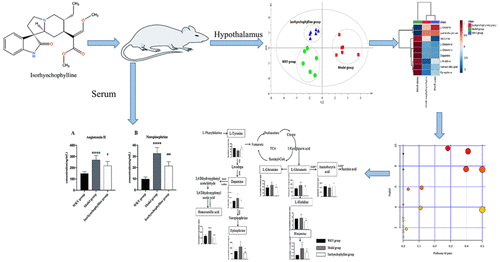当前位置:
X-MOL 学术
›
ACS Chem. Neurosci.
›
论文详情
Our official English website, www.x-mol.net, welcomes your
feedback! (Note: you will need to create a separate account there.)
Deciphering the Mechanism of the Anti-Hypertensive Effect of Isorhynchophylline by Targeting Neurotransmitters Metabolism of Hypothalamus in Spontaneously Hypertensive Rats.
ACS Chemical Neuroscience ( IF 4.1 ) Pub Date : 2020-05-01 , DOI: 10.1021/acschemneuro.9b00699 Yuan Li 1, 2, 3 , Ruixue Yu 4 , Dan Zhang 1, 2, 3 , Wenqing Yang 1, 2, 3 , Qingqing Hou 4 , Yunlun Li 1, 5 , Haiqiang Jiang 1, 2, 3
ACS Chemical Neuroscience ( IF 4.1 ) Pub Date : 2020-05-01 , DOI: 10.1021/acschemneuro.9b00699 Yuan Li 1, 2, 3 , Ruixue Yu 4 , Dan Zhang 1, 2, 3 , Wenqing Yang 1, 2, 3 , Qingqing Hou 4 , Yunlun Li 1, 5 , Haiqiang Jiang 1, 2, 3
Affiliation

|
Essential hypertension is a major risk factor for cardiovascular disease that can lead eventually to structural and functional alterations in the brain. Accumulating evidence has suggested that the increased activities in renin–angiotensin system and sympathetic nerve participated in the pathogenesis of hypertension that is related to the imbalance between neurotransmitters. The potential role in essential hypertension arising from alterations of neurotransmitters in the central nervous system remains understudied. Isorhynchophylline is a major oxindole alkaloid extracted from Uncaria rhynchophylla, which has been widely used for treating hypertension and neurodegenerative diseases. Whether isorhynchophylline acts on neurotransmitters to lower blood pressure has been hypothesized but rarely demonstrated unequivocally. Here, we studied the metabolic neurotransmitter profiles in the hypothalamus using a targeted metabolomic approach in spontaneously hypertensive rats after isorhynchophylline intervention. Our study demonstrated that isorhynchophylline exhibited a strong anti-hypertensive effect in spontaneously hypertensive rats by improving the neurotransmitter imbalance in the hypothalamus and inhibiting the overactivation of the renin–angiotensin system and sympathetic nerve system. Overall, this study played an essential role in enhancing our understanding of the mechanism of isorhynchophylline in essential hypertension and in providing theoretical evidence for future research and clinical application.
中文翻译:

以自发性高血压大鼠下丘脑神经递质代谢为靶标,阐明异吗啡茶碱的降压作用机制。
原发性高血压是心血管疾病的主要危险因素,可最终导致大脑结构和功能的改变。越来越多的证据表明,肾素-血管紧张素系统和交感神经活动的增加参与了高血压的发病机制,这与神经递质之间的失衡有关。由于中枢神经系统中神经递质的改变而引起的原发性高血压的潜在作用仍未得到充分研究。异丁香碱是从毛钩藤中提取的主要羟吲哚生物碱。,已被广泛用于治疗高血压和神经退行性疾病。异吗啡茶碱是否作用于神经递质以降低血压,但很少明确证实。在这里,我们研究了异吗啉茶碱干预后自发性高血压大鼠的下丘脑代谢神经递质概况,采用了靶向代谢组学方法。我们的研究表明,异去氧茶碱通过改善下丘脑的神经递质失衡并抑制肾素-血管紧张素系统和交感神经系统的过度活化,在自发性高血压大鼠中表现出强大的抗高血压作用。总体,
更新日期:2020-05-01
中文翻译:

以自发性高血压大鼠下丘脑神经递质代谢为靶标,阐明异吗啡茶碱的降压作用机制。
原发性高血压是心血管疾病的主要危险因素,可最终导致大脑结构和功能的改变。越来越多的证据表明,肾素-血管紧张素系统和交感神经活动的增加参与了高血压的发病机制,这与神经递质之间的失衡有关。由于中枢神经系统中神经递质的改变而引起的原发性高血压的潜在作用仍未得到充分研究。异丁香碱是从毛钩藤中提取的主要羟吲哚生物碱。,已被广泛用于治疗高血压和神经退行性疾病。异吗啡茶碱是否作用于神经递质以降低血压,但很少明确证实。在这里,我们研究了异吗啉茶碱干预后自发性高血压大鼠的下丘脑代谢神经递质概况,采用了靶向代谢组学方法。我们的研究表明,异去氧茶碱通过改善下丘脑的神经递质失衡并抑制肾素-血管紧张素系统和交感神经系统的过度活化,在自发性高血压大鼠中表现出强大的抗高血压作用。总体,


















































 京公网安备 11010802027423号
京公网安备 11010802027423号